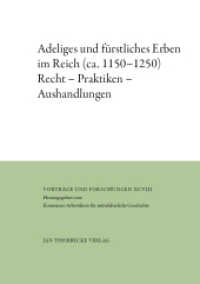Full Description
This edited volume explores theoretical and empirical issues related to monetary economics and policy in the Islamic financial system. Derived from the Conference on Islamic Monetary Economics and Institutions: Theory and Practice 2017 held in Malé, Maldives, the enclosed papers highlights several option for authorities and regulatory bodies regarding monetary policy and regulation, as well as discussing how Islamic monetary policy effects growth, financial stability and resilience to shocks in practice. The inter-linkage between Islamic monetary policy and other markets are also explored.
The subject of Islamic economics has gained considerable attention in the last four decades with the emergence of Islamic financial institutions around the world. This phenomenon has motivated economists to develop a comprehensive theoretical framework of modern monetary economics for Islamic economic system. An important characteristic of the Islamic economic system is the abolition of interest from the financial system. Islamic monetary economics is distinguished from conventional monetary economics due to the absence of interest. Therefore, under the Islamic economic system, monetary policy has to depend on other tools. In the early theoretical literature on Islamic monetary economics, many have discussed the role of money in Islamic economics system, while the number of empirical studies on Islamic monetary economics is a relatively new phenomenon. According to Islamic scholars, there are three main goals of Islamic monetary policy: a) economic well-being with full employment and optimum rate of economic growth; b) socioeconomic justice and equitable distribution of income and wealth and c) stability in the value of money. Hence, the Islamic monetary policy has several socioeconomic and ethical implications. Featuring regional case studies, this book serves as a valuable resource for academics, scholars, practitioners and policy makers in the areas of Islamic economics and finance.
Contents
Foreword.- Preface.- List of Contributors.- List of Figures.- List of Tables.- Chapter 1. Introduction.- Part I. Theoretical Foundation of Monetary Policy from Islamic Perspectives.- Chapter 2. Monetary Economics, Monetary Policy and Macroeconomic Model for an 'Islamic' Economy.- Chapter 3. Re-emergence of Islamic Monetary Economics: A Review of Theory and Practice.- Chapter 4. On Normative and Logical Foundations of Monetary Policy.- Chapter 5. Historical and Ideological of the Monetary Institutions: A Comparison Of Islamic and Austrian Schools Perspectives.- Part II. Monetary Policy, Policy Instruments and Financial Stability in Islamic Economy.- Chapter 6. Islamic Monetary Policy and its Instruments in Some Selected OIC Countries: An Assessment Highlighting Bangladeshi Economy.- Chapter 7. Islamic Financial Institutions and Participatory Finance Constraints.- Chapter 8. Pricing Deposit Insurance Premium In Islamic Banks.- Chapter 9. The Rate of Profit as a Monetary Policy Tools to Create Islamic Financial Stability and Promote Economic Growth.- Chapter 10. Stress Testing and Reverse Stress Testing: An Approach for a Resilient Islamic Financial Market and Institutions.- Chapter 11. The Impact of Monetary Policy on Islamic Bank Financing: Bank-Level Evidence from Malaysia.- Chapter 12. On The Dynamic Determinants of Participation Banks Liquidity Management In Turkey.- Part III. Interlinkage between Islamic Monetary Policy and Other Markets 13. Monetary Transmission via Wealth Effect in Indonesia: Evidence of Islamic and Conventional Indices.- Chapter 14. FinTech-enabled Islamic Financial System and Its Positive Effects on Financial Stability.- Glossary.- Index.








